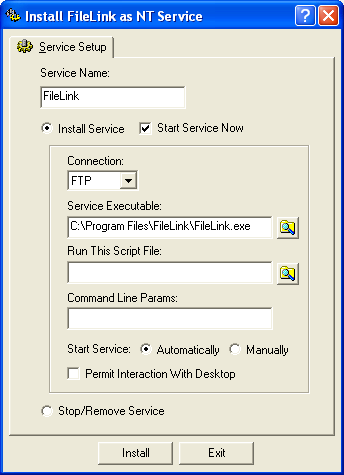FileLink may be installed as an NT Service under Windows NT, 2000, and XP. Services are not supported under Windows 98 or ME.
You must have administrator privileges you install the FileLink Service.
An NT Service is a background process which is loaded by the Service Control Manager of the Windows kernel. They are often loaded at bootup, before any user logs in, and are often independent of any specific user being logged on at the time. If a service is not launched automatically by the system at boot time, as many services are, it can also be manually launched by a user at the console, via the Windows Control Panel Services tool (under Administrative Tools using Windows 2000 and XP), or by another program which interfaces to Window’s Service Control Manager.
The SrvInstaller utility is installed along with FileLink. It is installed into the Windows Control Panel under the name FileLink Service Installer and it may also be found in the Start menu grouped with other FileLink components. This utility is used to install, optionally start, and to stop and/or remove the FileLink Service.
The SrvMonitor utility is also installed along with FileLink. SrvMonitor is a Windows desktop tray applet that any user can use to monitor the status of a running FileLink service. See Monitoring a FileLink Service.
A script file must be specified when running FileLink as a Service. The FileLink Service remains active as long as the script file permits it to. The STOP and EXIT commands stop the script and terminate the FileLink Service. Furthermore, unless you have selected the Interact with desktop option, interactive script commands such as ASK and PROMPT are not permitted.
A typical deployment of FileLink as a Service would probably have a script that runs continuously. Such a script file would use, for example, the CRON command to trigger one or more regularly scheduled activity, or use the GETNEXTFILE command to signal a new operation is to be initiated.
Important
It is strongly recommended that you fully test any script file that you intend to run using FileLink as a normal application program before using it with a Service.
If the FileLink Service is not started at installation time, you use the Windows Control Panel Services tool (under Administrative Tools using Windows 2000 and XP) to start the Service, or you should restart Windows (assuming that you selected Automatically as the Start Service Now method).
It is recommended that you use the Service installation utility SrvInstaller to stop and remove the FileLink Service rather than using the Windows Control Panel Services tool (under Administrative Tools using Windows 2000 and XP).
Unlike other NT Services, the FileLink Service does not log all results and errors to the System Event Log. Instead, you should use the FileLink log file to monitor operation of a FileLink Service that does not interact with the desktop.
The main screen of the SrvInstaller utility is shown below. Click on the fields within image below for more information.
